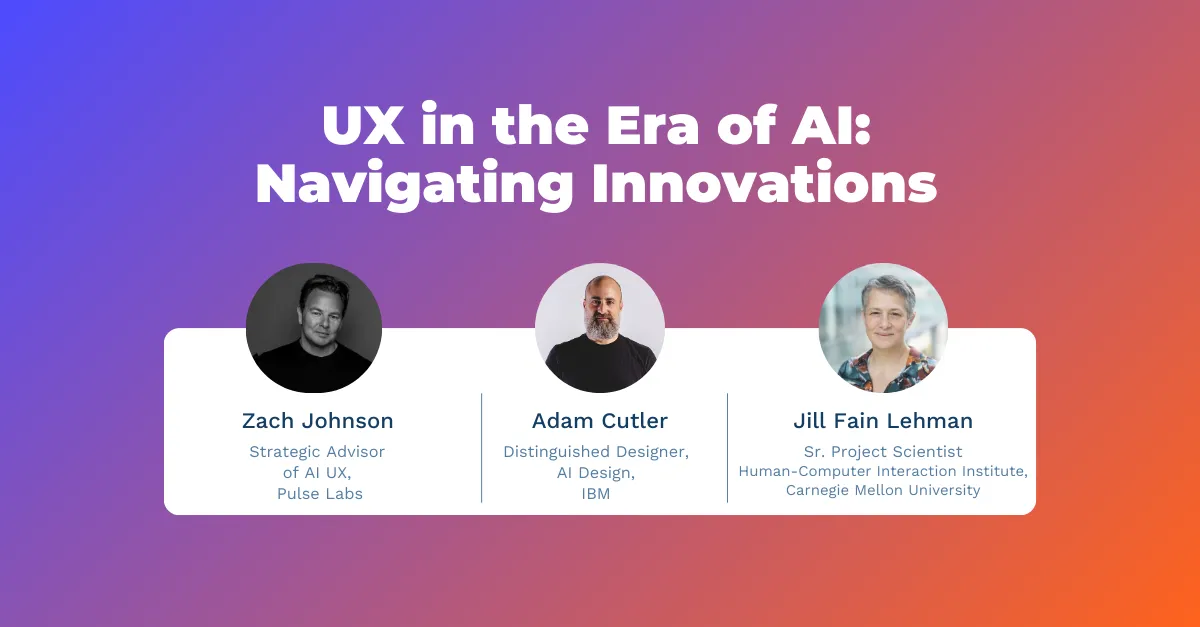The webinar “UX in the Era of AI: Navigating Innovations,” hosted by Pulse Labs, focused on the intersection of UX and AI, specifically the implications of large language models (LLMs) and generative AI in UX design. The speakers were Jill Fain Lehman, Senior Project Scientist at the Human-Computer Interaction Institute, Carnegie Mellon University, and Adam Cutler, Distinguished Designer of AI Design at IBM. Both guests emphasized the importance of understanding the human experience and the meaning behind language in AI interactions.
Jill highlighted the necessity of grounding AI-generated language in human experience, using a case study involving a voice assistant for post-surgical care to illustrate how language must be meaningful and trustworthy. She stressed the importance of ensuring AI interactions are identified as such to maintain trust.
Adam discussed the evolution of AI in design, emphasizing the need for purpose, value, and trust in AI systems. He shared insights on how IBM is integrating AI into its design processes, highlighting the importance of a unified design language for AI and the need for data literacy among designers.
Key Takeaways
- Human-Centered AI Design: Both speakers stressed the importance of keeping the human experience central in AI design. AI should enhance human interactions by being meaningful and trustworthy.
- Grounding Language in Experience: Jill emphasized that AI language must be grounded in human experiences to be meaningful. For AI to be effective, it must understand and convey the context and nuances of human language.
- Designing for Trust and Purpose: Adam highlighted that AI systems be designed with a clear purpose, intrinsic value for users, and built-in trust mechanisms. Ethical considerations and transparent communication about AI's role are crucial.
- AI as a Tool, Not a Replacement: While AI can assist in various tasks, it is not yet a full-fledged team member. It should be seen as a tool to enhance human capabilities, not replace them.
- Evolving AI Practices: Both speakers noted that AI technology is still nascent. Current AI systems like ChatGPT are just the beginning, and future advancements will require continuous adaptation and improvement in design practices. (Caveat: Open AI and Google both just took a massive step forward in the evolution of AI with their respective recent announcements)
- Educational and Ethical Considerations: There is a need for better UX design education about AI's capabilities and limitations. Ethical considerations must be at the forefront of AI development to prevent negative consequences and misuse.
- Specific Use Cases and Applications: The speakers provided examples of how AI can be integrated into specific applications, such as post-surgical care and business efficiency improvements, demonstrating the practical benefits and challenges of AI in real-world scenarios.
- Collaboration and Consistency in AI Design: Adam emphasized the importance of collaboration among product managers, developers, and designers in creating effective AI solutions. A consistent design language and framework for AI can help in achieving uniformity and effectiveness across applications.
The session concluded with a Q&A segment, reinforcing the points discussed and providing further insights into practical applications and future directions of AI in UX design. You can access the on-demand session here.
Have any questions about how the evolution of AI will impact UX or interested in learning more? Contact us.






